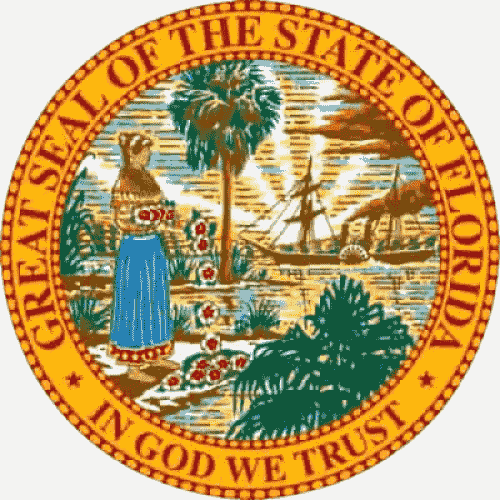 State Flag |  State Seal |
Florida is a state in the southeastern region of the United States, bordered to the west by the Gulf of Mexico, to the north by Alabama and Georgia, to the east by the Atlantic Ocean, and to the south by the Straits of Florida.
- ABBREVIATION: FL
- NICKNAME: The Sunshine State
- POPULATION: 23,372,215 (2024 est.)
- CAPITAL: Tallahassee
- STATE BIRD: Mockingbird
- STATE FLOWER: Orange Blossom
- AREA: 65,755 sq. mi.
- TIME ZONE: Peninsula and “Big Bend” region Eastern, Panhandle west of the Apalachicola River Central
- ENTERED UNION: Mar. 3, 1845
- ALTITUDE: High, 345 ft. Britton Hill
- CLIMATE: Hot humid summers, mild winters with occasional frost. Southern tip tropical. Heavy rains during hurricane season.
A 400 mile long peninsula with a coastline of nearly 1200 miles, Florida has baffled men for more than four centuries-beginning with Juan Ponce de Leon, the Spaniard who landed here in 1513 and thought he was on an island. Though it lies entirely north of the Tropic of Cancer, Florida’s tip has a tropical climate.
The terrain varies from gently rolling, pine-covered hills in the north to the luxuriant, steaming Everglades in the south, where giant orchid plants sometimes live for hundreds of years. Around the peninsula’s periphery, sand bars, coral reefs and keys are slowly creating new land out of the ocean.
Rich deposits of phosphate-an important component of fertilizer-have been found in central Florida; these deposits supply most of the needs of the U.S., as well as enrich the soils of Florida itself. Phosphate also nurtures the grass which has helped make Florida an important producer of beef. The state raises a breed of Brahman hybrid cattle that is resistant to heat and many kinds of pests.

Miami Florida Skyline
Above all else, Florida has found fortune in the vast number of people attracted by its climate. Every year throngs of people flock to Florida to vacation, fleeing the intemperate winters of the north, and a multitude of elderly people seeking-if not Ponce de Leon’s Fountain of Youth-at least a warm and comfortable “Isle of Flowers” for their quiet retirement years.
Fun Facts:
- Clearwater has the highest rate of per capita lightning strikes of any U.S. city.
- Ft. Lauderdale has 185 miles of local waterways, earning it the nickname of ‘Venice of America’.
- The Overseas Highway, which spans 113 miles between Key Largo and Key West, has more than 42 bridges and links more than a hundred islands. The longest is the Seven Mile Bridge.
- Counting bays and barrier islands along its Atlantic and Gulf coasts, Florida has 8,500 miles of shoreline. Alaska is the only state with more.
- The oldest European settlement in North America is Saint Augustine.
- Citrus fruits originated in Southeast Asia. Ponce de Leon planted the first citrus in Florida in the mid-1500’s.
History:
Florida’s history is a vivid tapestry woven with the stories of Native Americans, European explorers, colonial powers, and the growth of a modern and diverse state. Its strategic location and natural resources have made it a significant region for centuries.
Long before European contact, Florida was home to Indigenous peoples such as the Timucua, Calusa, Apalachee, and Tequesta.
These tribes built complex societies and adapted to the peninsula’s varied environments—from the forests of the north to the coastal mangroves and the Everglades in the south. They lived off hunting, fishing, and farming, and developed rich cultural and spiritual traditions.
In 1513, Spanish explorer Juan Ponce de León landed on the peninsula and named it “La Florida,” meaning “land of flowers.” He was searching for gold and the mythical Fountain of Youth. Spain laid claim to the region and established settlements, including St.
Augustine in 1565—the oldest continuously inhabited European-established city in the continental U.S. Despite this, Spanish control was constantly challenged by disease, Native resistance, pirates, and rival European powers, including France and Great Britain.
During the 18th century, Florida changed hands several times. It was ceded to Britain in 1763 after the Seven Years’ War, then returned to Spain in 1783 following the American Revolution. Finally, in 1821, Spain transferred Florida to the United States through the Adams-Onís Treaty, largely due to pressure from American settlers and military incursions led by Andrew Jackson.
Florida became a U.S. territory and was admitted as the 27th state in 1845. During this time, settlers pushed into Seminole lands, leading to the Seminole Wars—the longest and costliest of the Indian conflicts in U.S. history. These wars resulted in the forced removal of many Seminole people, though some remained in the Everglades.
Florida joined the Confederacy during the Civil War but saw relatively few major battles. After the war, it struggled through Reconstruction and eventually began rebuilding its economy through agriculture, especially citrus, and tourism.
The late 19th and early 20th centuries brought dramatic change. Railroads built by tycoons like Henry Flagler opened Florida’s east coast to development and tourism. Cities like Miami and Tampa began to grow rapidly.
World War II brought military bases and economic growth, and in the postwar period, Florida experienced a population boom as retirees, workers, and immigrants, especially from Cuba, Puerto Rico, and other parts of Latin America, moved in.
The 1960s marked Florida’s entrance into the space age with the establishment of NASA’s Kennedy Space Center at Cape Canaveral. The opening of Walt Disney World in 1971 transformed Central Florida into a global tourism destination.
Today, Florida is the third most populous U.S. state, known for its cultural diversity, environmental beauty, and political importance. Its history reflects centuries of change—from Native civilizations and European colonization to its role as a key economic, cultural, and technological center in modern America. Florida’s dynamic past continues to shape its vibrant and ever-evolving present.